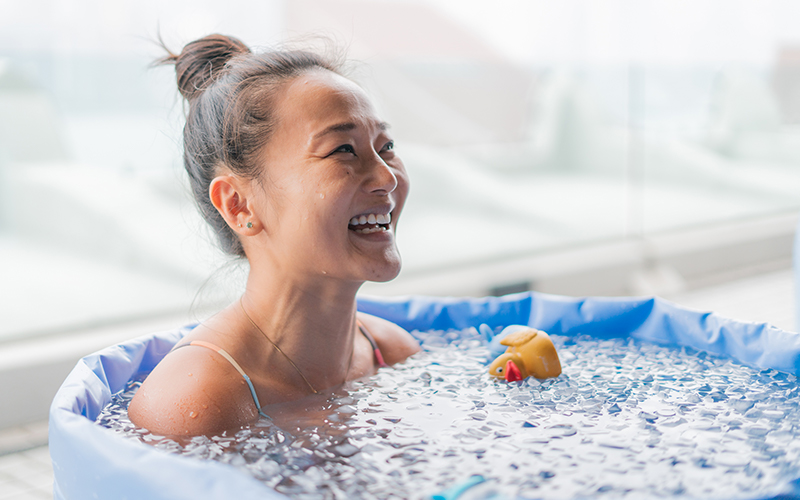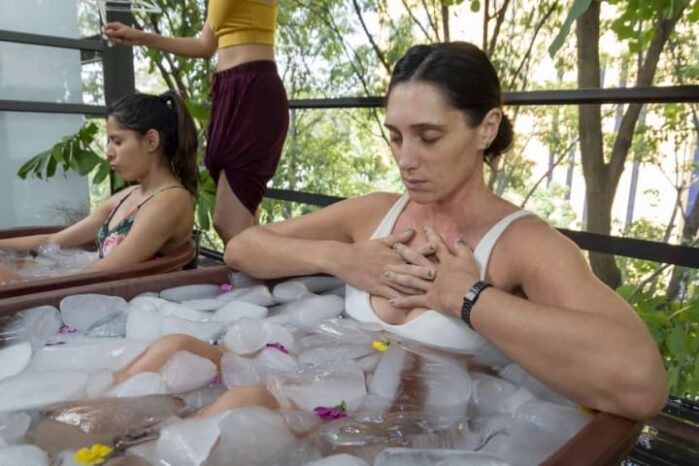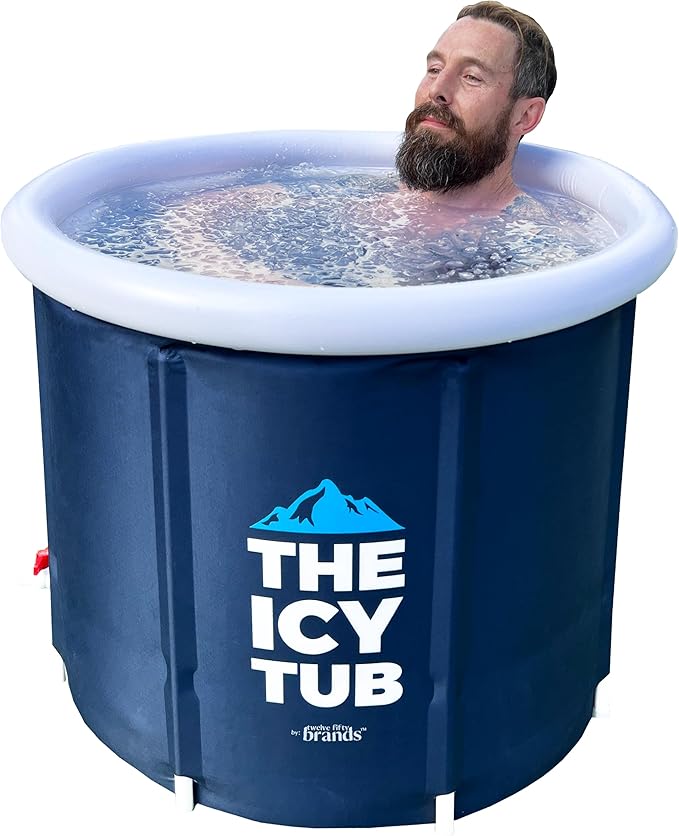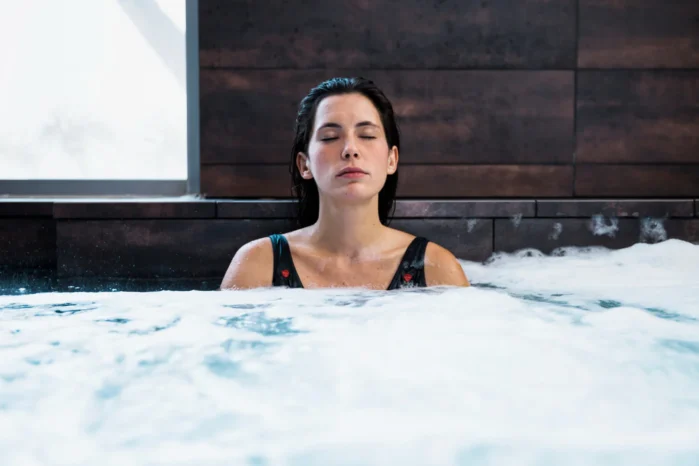
Ice baths can support weight loss by boosting metabolism and reducing inflammation. They may help burn calories through thermogenesis.
Ice baths, also known as cold-water immersion, have gained popularity for their potential weight loss benefits. Submerging the body in cold water can stimulate thermogenesis, a process where the body generates heat by burning calories. This not only helps in boosting metabolism but also aids in reducing inflammation and muscle soreness post-exercise.
Athletes and fitness enthusiasts often use ice baths to enhance recovery and performance. By incorporating ice baths into a regular fitness routine, individuals may find an additional method to support their weight loss goals. Always consult a healthcare provider before starting any new health regimen.
Ice Bath Benefits
Ice bath weight loss has gained popularity due to its surprising benefits. One of the key advantages is the various benefits of ice baths. These benefits include boosting metabolism and enhancing recovery. Below, we’ll explore these benefits in detail.

Boosts Metabolism
Ice baths can significantly boost your metabolism. When exposed to cold water, your body works harder to maintain its core temperature. This process, known as thermogenesis, increases calorie burning.
- Increased Calorie Burn: Cold exposure forces your body to burn more calories to stay warm.
- Activation of Brown Fat: Brown adipose tissue (BAT) gets activated in cold temperatures. BAT burns calories to generate heat.
- Enhanced Energy Expenditure: Your body uses more energy to maintain its temperature, leading to higher metabolism.
Here’s a table summarizing the impact of cold exposure on metabolism:
| Benefit | Description |
|---|---|
| Calorie Burn | Body burns more calories to generate heat. |
| Brown Fat Activation | BAT burns calories to produce heat. |
| Energy Expenditure | Increased energy use to maintain body temperature. |
Enhances Recovery
Ice baths are also known to enhance recovery, especially after intense workouts. Cold water immersion can reduce muscle soreness and inflammation.
- Reduces Inflammation: Cold water helps reduce swelling and inflammation in muscles.
- Decreases Muscle Soreness: Ice baths can help lower the feeling of muscle soreness after exercise.
- Improves Circulation: Alternating between cold and warm water can boost blood flow, aiding recovery.
Consider these points to understand how ice baths enhance recovery:
- Immersion Duration: Aim for 10-15 minutes in cold water for optimal results.
- Temperature: The water should be between 50-59°F (10-15°C).
- Frequency: Two to three times a week can be beneficial.
By leveraging the benefits of ice baths, you can not only aid weight loss but also ensure quicker recovery and better overall health.
Weight Loss Mechanism
Ice baths are becoming popular for weight loss enthusiasts. The cold temperature stimulates the body in unique ways. Let’s explore the weight loss mechanism of ice baths. 
Caloric Burn
One key benefit of ice baths is the increase in caloric burn. When the body is exposed to cold, it works harder to maintain its core temperature. This process, called thermogenesis, burns calories. Here’s how it works:
- The body shivers to generate heat.
- Shivering increases metabolic rate.
- Increased metabolism leads to more calories burned.
Studies suggest that cold exposure can increase calorie expenditure by 8-80%. This means you can burn more calories without extra exercise.
Consider this table for a clear picture:
| Temperature (°C) | Caloric Burn Increase (%) |
|---|---|
| 15 | 10% |
| 10 | 30% |
| 5 | 80% |
Colder temperatures mean more calories burned. So, ice baths can be a simple way to boost your weight loss efforts.
Fat Oxidation
Another important aspect of ice bath weight loss is fat oxidation. Cold exposure activates brown adipose tissue (BAT). BAT burns calories to produce heat, unlike white fat which stores energy.
Here’s a brief look at how BAT works:
- Cold exposure activates BAT.
- BAT burns fatty acids to generate heat.
- This process is called non-shivering thermogenesis.
Research indicates that BAT can increase fat oxidation significantly. This means more of your body fat is burned off as heat.
Here’s a comparison of white fat vs brown fat:
| Feature | White Fat | Brown Fat |
|---|---|---|
| Function | Stores energy | Burns energy |
| Color | White | Brown |
| Heat Production | Low | High |
Activating BAT through ice baths can be a powerful tool. It helps you burn more fat and lose weight faster.
Cold Exposure Science
Have you ever wondered how cold exposure helps with weight loss? Scientists have found that ice baths can boost weight loss. This process involves cold exposure science. When your body faces cold temperatures, it reacts in amazing ways. Here, we will explore the science behind this and how it aids in weight loss. 
Brown Fat Activation
Brown fat, also known as brown adipose tissue, is a special type of fat. Unlike white fat, which stores energy, brown fat burns energy to produce heat. Exposure to cold temperatures activates brown fat. This helps in burning more calories.
Brown fat activation has several benefits:
- Increases calorie burn: Brown fat burns calories to generate heat.
- Improves metabolism: Helps in boosting your metabolic rate.
- Weight loss: Burns stored fat, aiding in weight loss.
A study showed that people with more brown fat have a higher calorie burn rate. Regular cold exposure, like ice baths, can increase brown fat activity.
Here is a simple comparison between brown fat and white fat:
| Brown Fat | White Fat |
|---|---|
| Burns calories | Stores calories |
| Produces heat | Insulates body |
| Activated by cold | Stores energy |
Thermogenesis Process
Thermogenesis is the process of heat production in organisms. Cold exposure triggers thermogenesis in the body. This process helps in burning calories and thus aids in weight loss.
There are two types of thermogenesis:
- Shivering Thermogenesis: Occurs when you shiver to produce heat.
- Non-shivering Thermogenesis: Involves brown fat burning calories to produce heat.
During an ice bath, your body tries to maintain its core temperature. It does this by burning calories, which generates heat. This is the non-shivering thermogenesis process. As your body burns more calories, you lose weight.
Here are the steps of the thermogenesis process during cold exposure:
- Body detects cold temperature.
- Activates brown fat.
- Brown fat burns calories to produce heat.
- Increases metabolic rate.
- Burns stored fat, leading to weight loss.
Regular cold exposure, such as ice baths, can enhance this process. It helps you burn more calories and lose weight effectively.
Practical Tips
Ice baths are becoming a popular method for weight loss. The cold temperature helps boost metabolism and burns calories. To get the best results, it’s important to follow some practical tips. This guide will help you understand the optimal temperature and duration for ice baths.

Optimal Temperature
The temperature of your ice bath is crucial. The optimal range is between 50°F to 59°F (10°C to 15°C). This range is cold enough to trigger a metabolic response without causing harm. Make sure you use a thermometer to check the temperature.
Here are some tips for maintaining the optimal temperature:
- Use a thermometer: Always have a thermometer to monitor water temperature.
- Adjust with ice: Add or remove ice cubes to maintain the temperature.
- Mix the water: Stir the water to evenly distribute the cold.
For beginners, start at the higher end of the temperature range. As your body adapts, you can lower the temperature gradually. This will help prevent shock and make the process more comfortable.
Here’s a quick reference table:
| Experience Level | Temperature (°F) | Temperature (°C) |
|---|---|---|
| Beginner | 58°F – 59°F | 14°C – 15°C |
| Intermediate | 54°F – 57°F | 12°C – 13°C |
| Advanced | 50°F – 53°F | 10°C – 11°C |
Duration Guidelines
The duration of your ice bath is just as important as the temperature. Start with short durations and gradually increase as your body gets used to the cold. For beginners, aim for 5 to 10 minutes.
Also Read: Lemon Balm Recipes for Weight Loss
Here are some tips to follow:
- Start slow: Begin with 5 minutes if you’re new to ice baths.
- Increase gradually: Add 1 minute each week until you reach 15 minutes.
- Set a timer: Always use a timer to track your duration.
Advanced users can stay in an ice bath for up to 15 minutes. Staying longer than 15 minutes can be harmful. Always listen to your body. If you feel numb or experience any discomfort, get out immediately.
Here’s a quick reference guide for duration:
| Experience Level | Duration (Minutes) |
|---|---|
| Beginner | 5 – 10 |
| Intermediate | 10 – 15 |
| Advanced | 15 |
Use these guidelines to get the most out of your ice bath weight loss routine. Always be cautious and prioritize your safety.
Safety Precautions
Ice bath weight loss has gained popularity for its potential benefits in burning calories and boosting metabolism. Despite its advantages, safety precautions are essential to avoid adverse effects. This guide covers the necessary steps to ensure a safe and effective ice bath experience.
Avoiding Hypothermia
Hypothermia is a serious risk when taking ice baths. To stay safe, follow these steps:
- Limit the duration: Do not stay in the ice bath for more than 10-15 minutes.
- Monitor water temperature: Keep the water between 50-59°F (10-15°C).
- Gradual exposure: Start with short durations and gradually increase your time.
- Warm up afterward: Use warm clothes and blankets post-bath.
Having a timer and thermometer handy can help maintain safe conditions. Also, it’s wise to have someone nearby in case of emergencies. If you experience shivering, dizziness, or numbness, exit the bath immediately.
| Symptom | Action |
|---|---|
| Shivering | Get out of the bath and warm up |
| Dizziness | Exit the bath and hydrate |
| Numbness | Stop the session and seek warmth |
Health Conditions To Consider
Before trying ice baths, consider any existing health conditions. People with certain conditions should avoid this practice:
- Heart Disease: Cold exposure can strain the heart.
- Circulatory Issues: Ice baths can impede blood flow.
- Diabetes: Nerve damage can reduce your ability to feel cold.
- Raynaud’s Disease: Cold exposure can trigger symptoms.
Consulting a healthcare provider is crucial if you have any of these conditions. Make sure to discuss your plans and get personalized advice. If cleared by your doctor, always monitor your body’s response closely during and after the ice bath.
Understanding your body’s limits and respecting them is key to a safe ice bath experience. Stay informed and cautious to enjoy the benefits without compromising your health.
Post-bath Routine
Ice baths are increasingly popular for weight loss and recovery. The cold water can boost metabolism and reduce inflammation. But what happens after the bath? The post-bath routine is crucial for maximizing benefits. Let’s delve into the essential steps to follow.
Warming Up
After an ice bath, your body temperature drops significantly. It is essential to warm up to avoid hypothermia and discomfort. Here are some effective ways to warm up:
- Wear Warm Clothes: As soon as you get out of the ice bath, dry off and put on warm, dry clothes. A hoodie, sweatpants, and thick socks are ideal.
- Use a Heating Pad: A heating pad can help bring your body temperature back to normal. Place it on your chest or back for 10-15 minutes.
- Drink Warm Beverages: Sip on warm tea or hot water with lemon. This helps to warm your body from the inside out.
- Light Exercise: Gentle exercises like stretching or walking around the house can increase your blood flow and warmth.
Here is a quick comparison table for warming-up methods:
| Method | Effectiveness | Time Required |
|---|---|---|
| Warm Clothes | High | Immediate |
| Heating Pad | Moderate | 10-15 mins |
| Warm Beverages | Moderate | 5-10 mins |
| Light Exercise | High | 10-20 mins |
Hydration Importance
Hydration is crucial after an ice bath. Cold temperatures can dehydrate the body. Here are some key points to remember:
- Drink Plenty of Water: Aim to drink at least 16-20 ounces of water within 30 minutes post-bath.
- Electrolyte Balance: Consuming drinks with electrolytes can help replenish lost minerals. Coconut water or electrolyte tablets are good options.
- Avoid Caffeine: Caffeine can further dehydrate your body. Stick to water or herbal teas.
- Monitor Urine Color: Light yellow urine indicates proper hydration. Dark urine means you need more fluids.
Here’s a simple guideline for post-bath hydration:
| Action | Recommended Intake | Benefits |
|---|---|---|
| Water | 16-20 oz | Rehydrates body |
| Electrolyte Drinks | 1-2 servings | Restores minerals |
| Avoid Caffeine | Zero | Prevents dehydration |
| Monitor Urine | Check color | Ensures proper hydration |
Combining With Exercise
Ice baths have become a popular method for weight loss. Combining ice baths with exercise can amplify the benefits. This combination can help burn more calories, reduce muscle soreness, and boost overall fitness. Let’s explore the best workouts and timing strategies to maximize your results.
Best Workouts
Combining ice baths with the right workouts can supercharge your weight loss journey. Here are some of the best workouts to pair with ice baths:
- High-Intensity Interval Training (HIIT): HIIT workouts are short but intense. They involve bursts of intense exercise followed by short rest periods. This workout burns a lot of calories in a short time.
- Strength Training: Lifting weights builds muscle mass. More muscle means a higher metabolism. This helps burn more calories even at rest.
- Cardio Exercises: Running, cycling, and swimming are great cardio workouts. They increase heart rate and burn calories.
- Yoga: Yoga improves flexibility and reduces stress. It also helps with muscle recovery after intense workouts.
Here is a table showing the estimated calories burned for a 30-minute session of each workout:
| Workout | Calories Burned (30 mins) |
|---|---|
| HIIT | 300-400 |
| Strength Training | 200-300 |
| Cardio (Running) | 250-350 |
| Yoga | 150-250 |
Timing Strategies
Timing your ice baths and workouts correctly can enhance the benefits. Here are some strategies to consider:
- Post-Workout Ice Bath: Taking an ice bath right after a workout helps reduce muscle soreness. It also speeds up recovery.
- Morning Ice Bath: An ice bath in the morning can kickstart your metabolism. It wakes you up and prepares your body for the day.
- Evening Ice Bath: An ice bath in the evening can help relax your muscles. It also improves sleep quality.
Here is a suggested schedule for combining workouts and ice baths:
| Day | Workout | Ice Bath Timing |
|---|---|---|
| Monday | HIIT | Post-Workout |
| Wednesday | Strength Training | Post-Workout |
| Friday | Cardio | Morning |
| Sunday | Yoga | Evening |
By following these timing strategies, you can maximize the benefits of both your workouts and ice baths.
Real-life Experiences
Many people are turning to ice baths for weight loss. Real-life experiences provide valuable insights into this unique method. These stories highlight both the successes and the challenges faced by individuals on their cold journey.
Related Article: Trampoline Exercises for Weight Loss
Success Stories
Many have found success with ice baths for weight loss. John, a 35-year-old fitness enthusiast, lost 20 pounds in three months. He combined ice baths with regular exercise and a healthy diet.
Another success story is Maria, a busy mom of two. She managed to shed 15 pounds in two months. She took ice baths every other day and noticed a significant reduction in her belly fat.
Here are some common benefits reported by those who succeeded:
- Increased metabolism: Cold exposure boosts calorie burning.
- Reduced inflammation: Helps muscles recover faster.
- Improved mood: Cold water releases endorphins, making people feel happier.
A comparison of weight loss experiences:
| Name | Age | Weight Lost | Duration |
|---|---|---|---|
| John | 35 | 20 lbs | 3 months |
| Maria | 29 | 15 lbs | 2 months |
These success stories show how ice baths can be effective for weight loss. Combining this method with a balanced diet and exercise yields the best results.
Challenges Faced
Despite the success, many face challenges with ice baths for weight loss. Tom, a 40-year-old office worker, found it hard to maintain the routine. He experienced severe shivering and discomfort, making it difficult to stick with the regimen.
Sarah, a college student, had a tough time adjusting to the cold. She struggled with the initial shock and often felt too cold to continue. Her weight loss was minimal due to inconsistency.
Common challenges include:
- Temperature tolerance: Many people find it hard to endure the cold.
- Time commitment: Ice baths require time and preparation.
- Health concerns: Those with certain medical conditions may find ice baths risky.
A table of challenges faced by individuals:
| Name | Challenge | Outcome |
|---|---|---|
| Tom | Severe shivering | Discontinued |
| Sarah | Initial shock | Minimal weight loss |
These challenges highlight the difficulties some face with ice baths. It’s important to weigh the pros and cons before starting this method for weight loss.
Also Read: How to Raise Your Core Body Temperature
Frequently Asked Questions
What Are The Benefits Of Ice Baths For Weight Loss?
Ice baths may help boost metabolism and reduce inflammation. Cold exposure can stimulate brown fat, which burns calories. They also aid muscle recovery.
How Long Should You Stay In An Ice Bath?
For effective results, limit ice baths to 10-15 minutes. Longer exposure isn’t necessary and could be harmful. Always listen to your body.
Can Ice Baths Replace Regular Exercise For Weight Loss?
No, ice baths can’t replace regular exercise. They can supplement your fitness routine but are not a standalone solution for weight loss.
Are Ice Baths Safe For Everyone?
Ice baths aren’t safe for everyone. People with heart conditions or cold sensitivity should avoid them. Always consult a doctor first.
Ice baths can aid weight loss by boosting metabolism and reducing inflammation. Incorporate them into a balanced routine. Always consult a healthcare professional before starting. Remember, no single method works for everyone. Combine ice baths with a healthy diet and regular exercise for the best results.
Stay consistent and patient.









